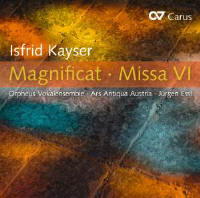Texte paru dans: / Appeared in: |
|
|
Outil de traduction ~ (Très approximatif) |
|
|
Reviewer: Bertil
van Boer He was known as the Caesar of monastic musicians in the southern part of the German realms of the Holy Roman Empire. Pater Isfrid Kayser (1712–1771) is today one of the many obscure composers who lavished their talents in published editions fit for virtually every church, leading an entire industry of music publishing in the region which is only now beginning to be exhumed. Kayser (that would be Caesar in German, hence the pun on his name) was a Premonstratensian monk in Marchtal, who functioned, as so many of his brethren, as regens cori (or musical director) and culinaris (or head cook) at his monastery. Why food and music seemed to go together in these places has never been explored, but this seems to have been only a tithe of his productive life. He regularly published his music in Augsburg, produced sacred musical dramas for the Jesuit colleges there and in nearby Ulm, and distributed his works among the various monasteries and abbeys in the region, earning himself a high reputation for the quality and beauty of his sacred music. Like a huge number of his monastic colleagues, however, his contributions remained tucked away in inaccessible (or largely untouched) monastic libraries or church archives, with their travels along what I like to call the Benedictine Road (though with other orders also represented therein) hardly researched or placed historically.
Thanks to several sorts of subventions, some of this music is now being published piecemeal, and here Carus Verlag has provided an aural sampling of a minimal tithe. These include a Mass, Magnificat, and four motets (texts generally drawn from Vespers or Litanies), along with one of his organ suites (entitled Parthia) published in a collection from 1746. These have already been recorded on fortepiano by Wolfgang Weller, though it seems to have been something locally produced. The rather lacunar booklet notes seem to imply that Kayser was using Couperin as his model, but though the three movements do have Baroque dance antecedents, I find them more akin to Central German organ music than the French style. They are well written, idiomatic for the instrument (hence they sound a bit pale on the excerpt from the Weller disc on fortepiano), and even the sprightly gigue has more to do with Bach than anything French.
The main focus, of course, is the sacred works, some of which have horns or trumpets (and occasionally timpani) ad libitum. The first work, Laudate pueri, has some impressive registral leaps in the sopranos, and the opening reminds one of Mozart’s Regina coeli (K 276). The sections are short and well composed, especially the duet with the tenor and bass, with its echoing sequences. The Susum corda is quite operatic, with broad flourishes in the solo soprano, performed ably by Johanna Pommranz. The Alma redemptoris mater, with its halting, lyrical alto solo is more mysterious, yet does not eschew cautious coloratura. Kayser uses his texture carefully, reducing the string accompaniment to provide contrast and lend it an air of mystery. The occasional mezza di voce eases the introduction of the chorus as a brief refrain. The Laudate Dominum begins with a rather complex fugue on a particularly gnarly (yet not chromatic) line. The forward motion stops rather abruptly as the soloists enter with an interlude featuring gentle suspensions punctuated by unison string rhythmic motives. The Amen section is more homophonic.
The main course here is the Mass, No. 6 in a collection of six. As sometimes happens with the works of Joseph Haydn, the opening Kyrie ambiguously hovers between major and minor before transitioning into a nicely formed fugue. The Gloria with its flashing horns is joyous and uncomplicated, while the Credo continues the mood, with swirling strings outlining the mostly homophonic chorus. Kayser chooses to set the Et incarnates est with a hymn, stately marching into the Crucifixus before a return to the bright horns and strings at the Et resurrexit. The Benedictus is a gentle tenor solo, lyrical and calm, while the Osanna is based around a brief fugue. The Agnus Dei is plaintive, and yet Kayser refrains from the usual Dona nobis pacem by concluding the Mass on an introspective note. The final Magnificat is festive and shows the brilliance of monastic composition of that era.
As for the performance, the Ars Antiqua Austria under the capable direction of Jürgen Essl is spot-on in terms of the style of this music. They know instinctively when to provide a thick texture and when to back off. The choral work of the Orpheus Vokalensemble is full and yet the diction is clear, never muddy. The often tortuous lines are handled with ease. The soloists are all equally adept, and though Pommranz can have a bit of vibrato wobble from time to time, all blend well. In short, this is a fine disc with music that should demonstrate that monastic composers were no slouches when it came to music. This is a field that contains an enormous range of hidden treasures that really need to be unearthed and recorded. This is a good first step. | |
|
Support us financially by purchasing this disc from eiher one of these suppliers. Un achat via l'un ou l'autre des fournisseurs proposés contribue à défrayer les coûts d'exploitation de ce site. |
|
|
|
|
|
Cliquez l'un ou l'autre
bouton pour découvrir bien d'autres critiques de CD |
|




